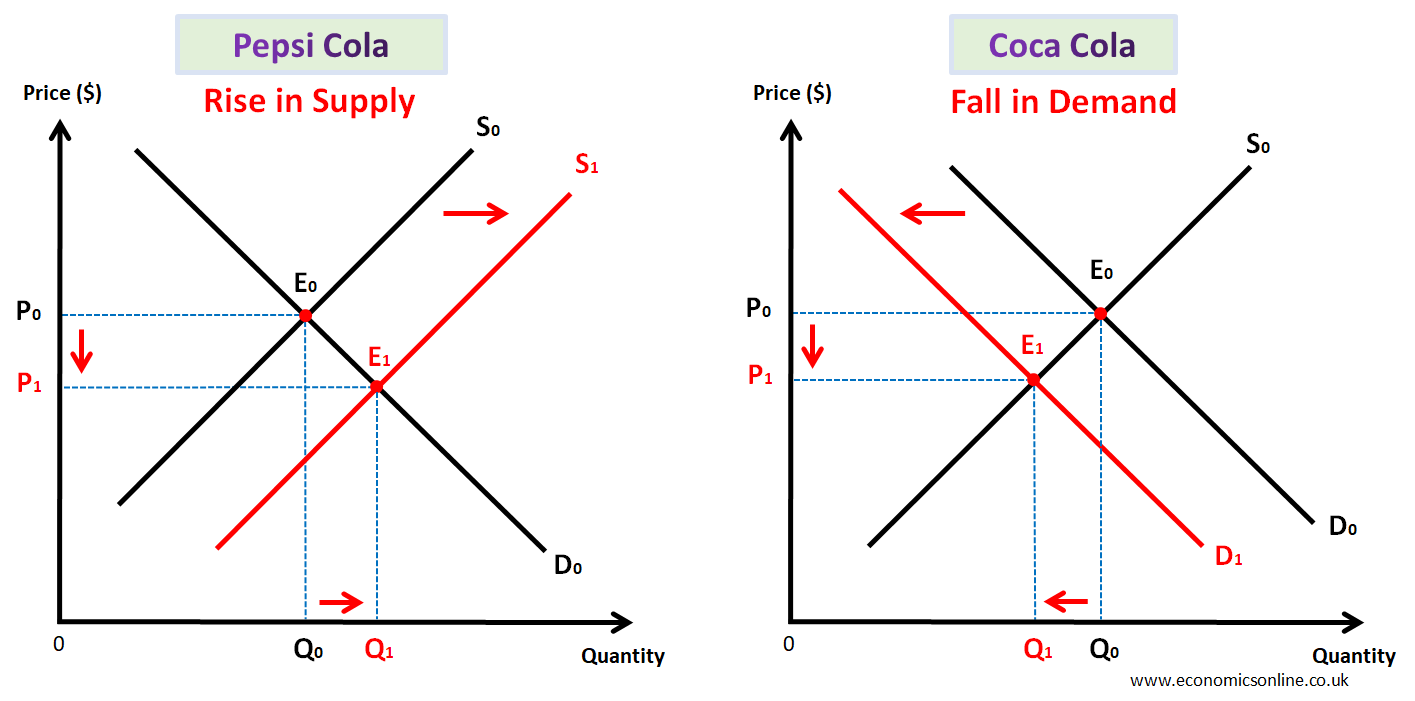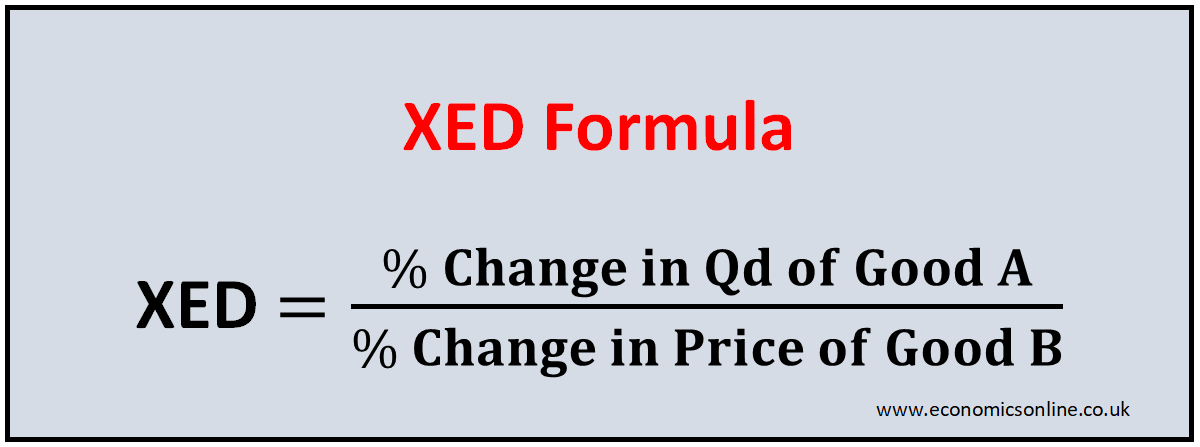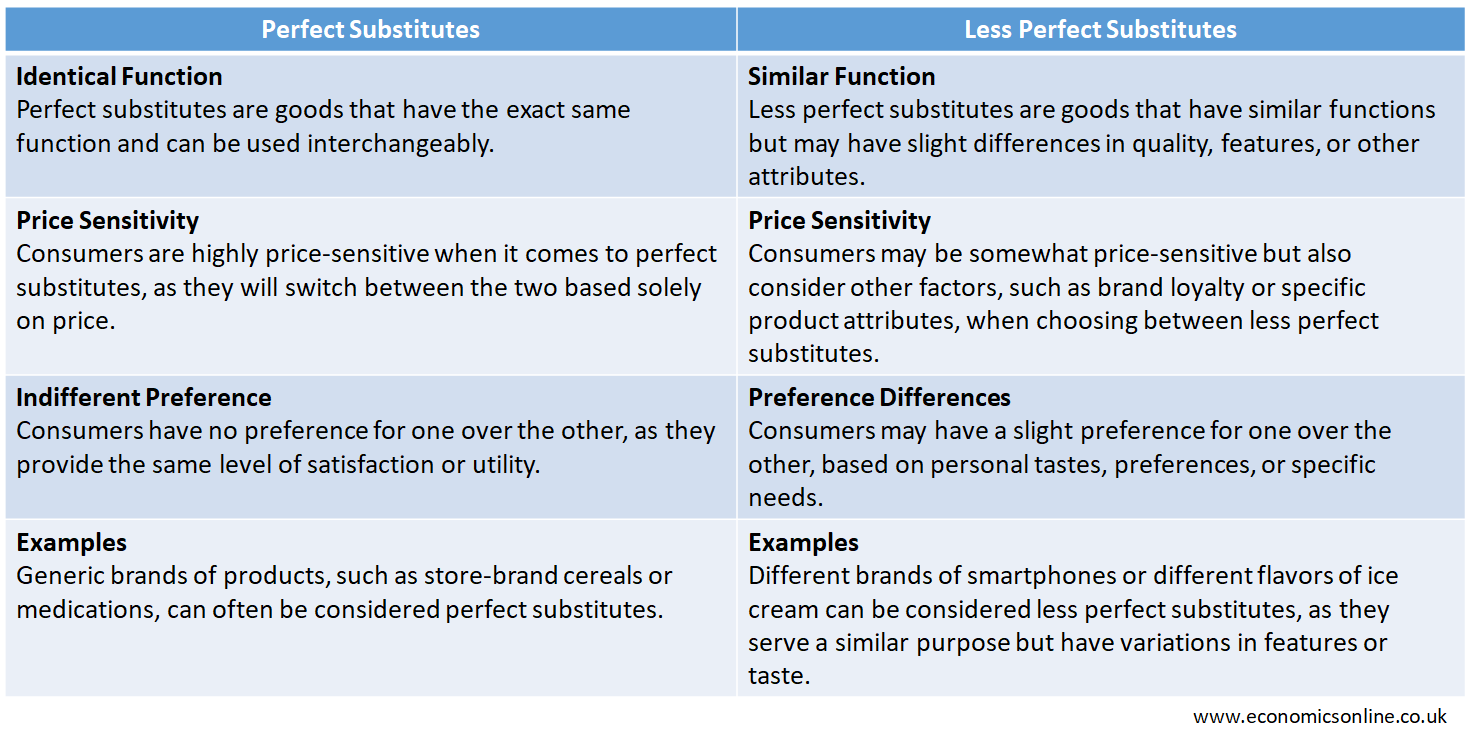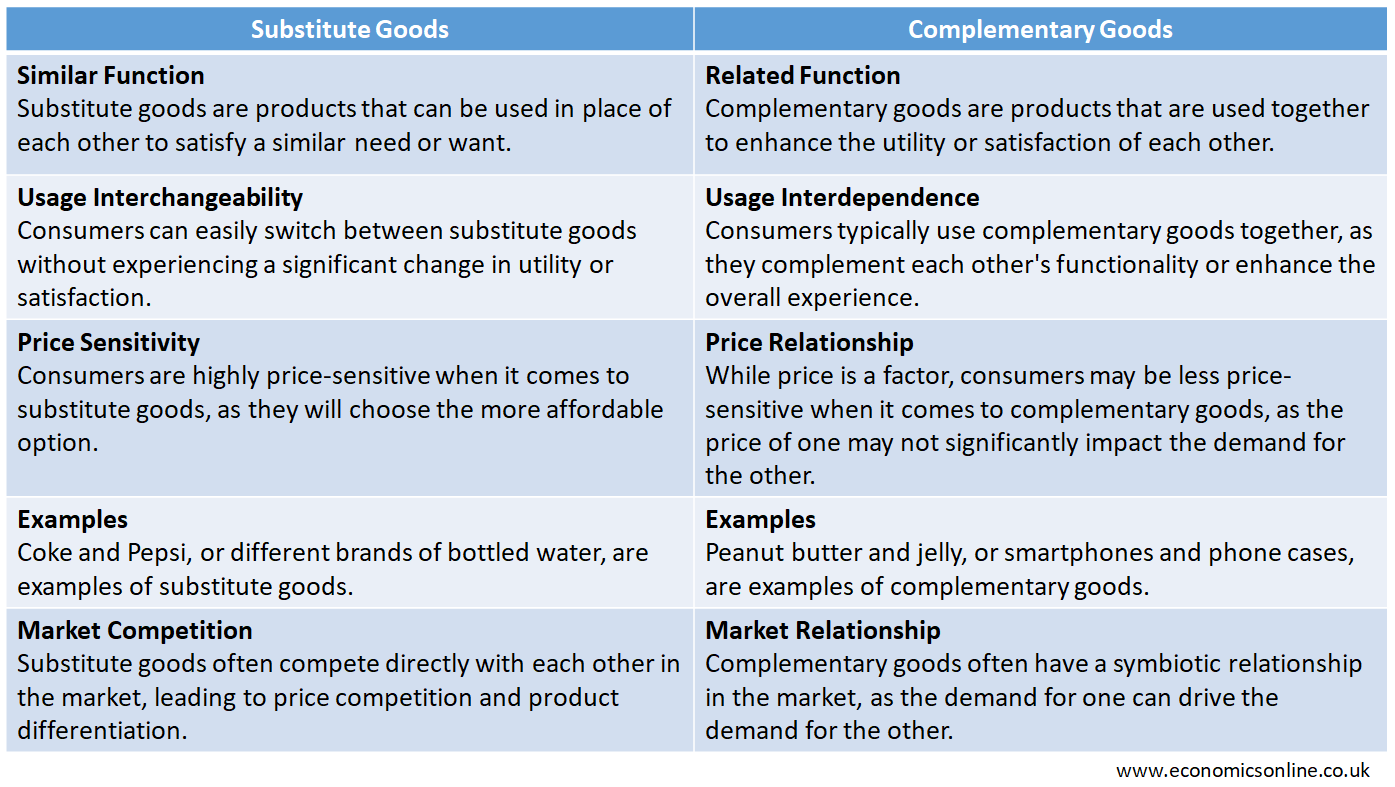
Photo by catrina farrell / Unsplash
Substitutes Economics
What are Substitutes?
Substitutes or substitute goods refer to the products that are used as alternatives to each other. These are alternatively demanded goods that satisfy the same need or want.
In simple words, a substitute good is a product or service that is used in place of another.
Examples
For example, if a person does not like the taste of coffee or the price of coffee is high, the person might use tea as an alternative; hence, tea and coffee are substitutes. Some other examples of substitute goods are Pepsi and Coca-Cola, tooth paste and tooth powder, ink and ball pens, butter and margarine, an Android phone, and an Apple iphone.
Graphs
Let's consider two substitutes: Pepsi and Coca-Cola. The economic relationship between the price of Pepsi and the quantity demanded of Coke is positive. This relationship is illustrated by using the following graphs:

In the above diagram, we have two graphs comparing two substitute goods. In the left graph, we have the market for Pepsi Cola, and the initial equilibrium is at E0. In this scenario, if the supply of Pepsi is increased from S0 to S1, the price decreases from P0 to P1, and there will be high demand for Pepsi as the quantity demanded will increase from Q0 to Q1. The demand curve shows the increase in the quantity demanded of Pepsi with a decreasing price. In the right graph, we have the market for Coca-Cola. In this scenario, there is a leftward shift of demand for Coca-Cola (substitute) from D0 to D1 due to a fall in the price of Pepsi. The price of Coca-Cola decreased from P0 to P1, and the quantity traded also decreased from Q0 to Q1.
In this situation, Pepsi is used as an alternative or substitute for Coca-Cola, and people are using more Pepsi because it becomes a cheaper alternative to Coca-Cola.
Cross-Elasticity of Demand
The degree of responsiveness of the quantity demanded of one good to the change in the price of another good alone is called Cross Elasticity of demand (XED).
XED is calculated by using the following formula:
XED = % Change in Qd of Product A / % Change in Price of Product B

In economics, the relationship between any two goods can be explained by using the concept of cross elasticity of demand (XED) or cross-price elasticity of demand.
In substitute economics, the cross-elasticity of demand is always positive. This explains why, when the price of one product increases, the demand for another product or substitute product increases because customers are more likely to prefer affordable goods or services.
Here are some important points:
- A positive cross-elasticity of demand means that the goods are substitutes.
- A negative cross-elasticity of demand means that the goods are complements.
- A zero cross-elasticity of demand means that the goods are unrelated goods.
XED Example
Let’s take tea and coffee as substitutes and calculate XED as an example. Suppose that a 10% price increase for tea leads to a 30% rise in the demand for coffee.
In this case, XED = +30%/+10% = +3
This positive cross-price elasticity of demand indicated that tea and coffee are substitutes.
Strength of Substitutes
The numerical value of XED with a positive sign shows the strength of substitutes. A lower positive cross elasticity of demand means weak substitutes while a higher positive value means strong or close substitutes.
Types of Substitute Goods
The following are some types of substitute goods, which are explained below:
Brand Substitutes
Brand substitutes are products from different brands that are used for similar purposes. For example, soft drinks such as Canon and Nikon digital cameras. Both are used for photography and videography and are known brands in the marketplace.
Generic Substitutes
Generic substitutes are unbranded products that are similar to a well-known brand. For example, generic ibuprofen rather than a specific brand like Advil.
Close Substitutes
Close substitutes are products that bear a close resemblance in terms of features, functionality, price, etc. For example, some smartphones have similar features and can be considered as close substitutes.
Perfect Substitutes
Perfect substitutes are products that are totally identical to each other in terms of features and functionality.
Imperfect Substitutes
Imperfect substitutes are products that are similar but not identical to other alternative brands. For example, brands for sneakers, makeup, coffee, etc.
Within Category Substitutes
Within-category substitutes are products that are related to the same category or industry of goods and can also be used as substitutes for each other. Different car models and brands for soda are examples of within-category substitutes.
Cross Category Substitutes
Cross-category substitutes are products that belong to different categories or industries but can also be used as alternatives for the same purpose. For example, an increase in the price of a movie ticket can lead to increased demand for online movie streaming platforms.
Perfect Substitutes vs. Less Perfect Substitutes
The following table contains the main features of perfect substitutes and less perfect substitutes.

Substitute Goods vs. Complementary Goods
Substitute goods (substitutes) are alternatively demanded goods, while complementary goods (complements) are jointly demanded goods. A complementary good is a good that adds value to another, or, a good that cannot be used without each other. Some examples of complementary products are, tooth paste and tooth brush, car and petrol, pen and ink, computer and hard disk, mobile and battery.
The following table contains the main points of difference between substitute goods and complementary goods.

Market Effects on Substitute Products
The following points explain the market effects on the substitute products:
Price Competition
In a market with many substitute products, competition among them can drive down prices as they try to attract customers.
Innovation and Differentiation
To stand out in a crowded market, substitute products may innovate or differentiate themselves to offer unique features or benefits to consumers.
Market Saturation
If a market becomes saturated with substitute products, it can lead to intense competition and potentially lower profit margins for manufacturers and sellers.
Market Dynamics
Changes in market conditions, such as shifts in consumer demand or the introduction of new technologies, can impact the popularity and demand for substitute products.
Impact of Substitute Products
The following are some impacts of substitute products:
Increased Competition
Substitute products cause an increase in competition because the availability of substitute products can lead to lower prices for products or services. This competition can lead to better-quality products because companies have to retain their customers and attract them to increase demand for their products.
Price Sensitivity
Price sensitivity also has a powerful impact on companies, as consumers are more price-sensitive. When the price of necessary goods rises too high, consumers shift toward cheaper products as a substitute for their needs. This will put pressure on the companies to keep their prices competitive.
Consumer Choice
Consumers choices also affect the substitute products, as customers have more choices and options to choose from and select the products that best suit their needs, budgets, preferences, etc.
Innovation and Differentiation
Innovation and differentiation have a positive impact on substitute products as more individuals and businesses are encouraged to innovate new features in their products and differentiate their products from their competitors by adding additional functions to them. This will enhance their sales and attract new customers to their products.
Factors affecting the Substitute Products
The following factors affect the demand for substitute products, which are explained as follows:
Price
Price also affects the demand for substitute products. When the price of a product increases, people prefer to buy a substitute. This will reduce the demand for that product but increase the demand for substitute products.
Availability
The availability of substitute products can impact demand. If a substitute becomes more readily accessible, demand for it may increase.
Quality
If the quality of a substitute product improves, it may attract more consumers and increase demand.
Marketing and Promotion
Effective marketing and promotion of substitute products can influence consumer preferences and drive up demand.
Consumer Preferences
Consumer preferences and tastes can also affect the demand for substitute products. Changes in preferences or trends can lead to shifts in demand.
Substitutes and Market Structure
Perfect competition
Perfect competition refers to a market structure in which sellers offer identical or highly similar substitute products. In this situation, there are no barriers to entry or exit for individuals and businesses, and sellers have the same access to technology and available resources.
In this type of market structure, all the sellers are price takers, which mean that the sellers have no control over the price of their products. They have to accept the price determined by the marketplace.
In perfect competition, firms sell perfect substitutes.
Monopolistic competition
Monopolistic competition refers to a market structure in which many sellers are present, offering similar substitutes, but these substitutes are not identical to each other. In this situation, there is some degree of barrier to entry or exit in the market for individuals and businesses.
In this type of market structure, sellers have some control over the price of their products. They can determine the price of it and also have the ability to negotiate it. In monopolistic competition, the sellers differentiate their products through marketing strategies, branding, product features, designs, etc.
In monopolistic competition, firms sell close substitutes which a slightly differentiated.
Conclusion
In conclusion, substitutes provide alternative products for consumers to satisfy their needs. Substitutes are the choices that encourage competition between firms in the marketplace. Firms differentiate their products by innovating new features and adding them to their products to compete with their rival firms. These strategies can enhance the quality of their products.


